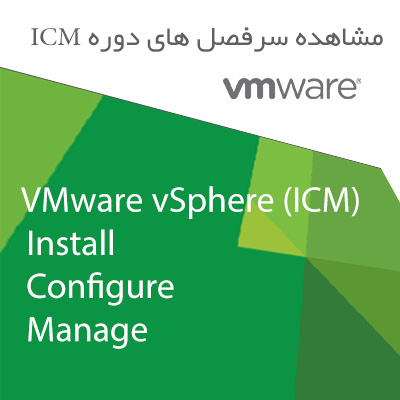مروری بر دوره
VMware vSphere: Install, Configure, Manage
This course features intensive hands-on training that focuses on installing, configuring, and managing VMware vSphere® ۶.۵, which includes VMware ESXi™ ۶.۵ and VMware vCenter Server® ۶.۵. This course prepares you to administer a vSphere infrastructure for an organization of any size. It is the foundation for most other VMware technologies in the software-defined data center
آنچه می آموزید
Describe the software-defined data center
Explain the vSphere components and their function in the infrastructure
Deploy an ESXi host
Deploy VMware vCenter® Server Appliance™
Use a local content library as an ISO store and deploy a virtual machine
Describe vCenter Server architecture
Use vCenter Server to manage an ESXi host
Configure and manage vSphere infrastructure with VMware Host Client™ and VMware vSphere® Web Client
Describe virtual networks with vSphere standard switches
Configure standard switch policies
Use vCenter Server to manage various types of host storage: VMware vSphere® VMFS, NFS, iSCSI, and RDM
Examine the features and functions of Fibre Channel and VMware vSAN™
Manage virtual machines, templates, clones, and snapshots
Create, clone, and deploy a vApp
Describe and use the content library
Migrate virtual machines with VMware vSphere® vMotion®
Use VMware vSphere® Storage vMotion® to migrate virtual machine storage
Monitor resource usage and manage resource pools
Use esxtop to identify and solve performance issues
Discuss the VMware vSphere® High Availability cluster architecture
Configure vSphere HA
Manage vSphere HA and VMware vSphere® Fault Tolerance
Use VMware vSphere® Replication™ and VMware vSphere® Data Protection™ to replicate virtual machines and perform data recovery
Use VMware vSphere® Distributed Resource Scheduler™ clusters to improve host scalability
Use VMware vSphere® Update Manager™ to apply patches and perform basic troubleshooting of ESXi hosts, virtual machines, and vCenter Server operations
سرفصل ها
۱ Course Introduction
Introductions and course logistics
Course objectives
Describe the content of this course
Gain a complete picture of the VMware certification system
Familiarize yourself with the benefits of the VMware Education Learning Zone
Identify additional resources
۲ Introduction to vSphere and the Software-Defined Data Center
Describe the topology of a physical data center
Explain the vSphere virtual infrastructure
Define the files and components of virtual machines
Describe the benefits of using virtual machines
Explain the similarities and differences between physical architectures and virtual architectures
Define the purpose of ESXi
Define the purpose of vCenter Server
Explain the software-defined data center
Describe private, public, and hybrid clouds
۳ Creating Virtual Machines
Introduce virtual machines, virtual machine hardware, and virtual machine files
Identify the files that make up a virtual machine
Discuss the latest virtual machine hardware and its features
Describe virtual machine CPU, memory, disk, and network resource usage
Explain the importance of VMware Tools™
Discuss PCI pass-through, Direct I/O, remote direct memory access, and NVMe
Deploy and configure virtual machines and templates
Identify the virtual machine disk format
۴ vCenter Server
Introduce the vCenter Server architecture
Deploy and configure vCenter Server Appliance
Use vSphere Web Client
Back up and restore vCenter Server
Examine vCenter Server permissions and roles
Explain the vSphere HA architectures and features
Examine the new vSphere authentication proxy
Manage vCenter Server inventory objects and licenses
Access and navigate the new vSphere clients
۵ Configuring and Managing Virtual Networks
Describe, create, and manage standard switches
Configure virtual switch security and load-balancing policies
Contrast and compare vSphere distributed switches and standard switches
Describe the virtual switch connection types
Describe the new TCP/IP stack architecture
Use VLANs with standard switches
۶ Configuring and Managing Virtual Storage
Introduce storage protocols and storage device types
Discuss ESXi hosts using iSCSI, NFS, and Fibre Channel storage
Create and manage VMFS and NFS datastores
Describe the new features of VMFS 6.5
Introduce vSAN
Describe guest file encryption
۷ Virtual Machine Management
Use templates and cloning to deploy new virtual machines
Modify and manage virtual machines
Clone a virtual machine
Upgrade virtual machine hardware to version 12
Remove virtual machines from the vCenter Server inventory and datastore
Customize a new virtual machine using customization specification files
Perform vSphere vMotion and vSphere Storage vMotion migrations
Create and manage virtual machine snapshots
Create, clone, and export vApps
Introduce the types of content libraries and how to deploy and use them
۸ Resource Management and Monitoring
Introduce virtual CPU and memory concepts
Explain virtual memory reclamation techniques
Describe virtual machine overcommitment and resource competition
Configure and manage resource pools
Describe methods for optimizing CPU and memory usage
Use various tools to monitor resource usage
Create and use alarms to report certain conditions or events
Describe and deploy resource pools
Set reservations, limits, and shares
Describe expandable reservations
Schedule changes to resource settings
Create, clone, and export vApps
Use vCenter Server performance charts and esxtop to analyze vSphere performance
VMware vSphere: Install, Configure, Manage
VMware, Inc. 3401 Hillview Avenue Palo Alto CA 94304 USA Tel 877-486-9273 Fax 650-427-5001 www.vmware.com
© ۲۰۱۷ VMware, Inc. All rights reserved. The product or workshop materials is protected by U.S. and international copyright and intellectual property laws. VMware products are covered by one or more patents listed
at http://www.vmware.com/download/patents.html. VMware is a registered trademark or trademark of VMware, Inc. in the United States and/or other jurisdictions. All other marks and names mentioned herein may be
trademarks of their respective companies.
VMware warrants that it will perform these workshop services in a reasonable manner using generally accepted industry standards and practices. THE EXPRESS WARRANTY SET FORTH IS IN LIEU OF ALL OTHER WARRANTIES,
EXPRESS, IMPLIED, STATUTORY OR OTHERWISE INCLUDING IMPLIED WARRANTIES OF MERCHANTABILITY OR FITNESS FOR A PARTICULAR PURPOSE WITH RESPECT TO THE SERVICES AND DELIVERABLES
PROVIDED BY VMWARE, OR AS TO THE RESULTS WHICH MAY BE OBTAINED THEREFROM. VMWARE WILL NOT BE LIABLE FOR ANY THIRD-PARTY SERVICES OR PRODUCTS IDENTIFIED OR REFERRED TO
CUSTOMER. All materials provided in this workshop are copyrighted by VMware (“Workshop Materials”). VMware grants the customer of this workshop a license to use and make reasonable copies of any Workshop Materials strictly for
the purpose of facilitating such company’s internal understanding, utilization and operation of its licensed VMware product(s). Except as set forth expressly in the sentence above, there is no transfer of any intellectual property rights or
any other license granted under the terms of this workshop. If you are located in the United States, the VMware contracting entity for the service will be VMware, Inc., and if outside of the United States, the VMware contracting entity will
be VMware International Limited.
VMware SKU: EDU-VSICM65-OE Rev. 1/2017
۹ vSphere HA, vSphere Fault Tolerance, and Protecting Data
Explain the vSphere HA architecture
Configure and manage a vSphere HA cluster
Use vSphere HA advanced parameters
Define clusterwide restart ordering capabilities
Enforce infrastructural or intra-app dependencies during failover
Describe vSphere HA heartbeat networks and datastore heartbeats
Introduce vSphere Fault Tolerance
Enable vSphere Fault Tolerance on virtual machines
Support vSphere Fault Tolerance interoperability with vSAN
Examine enhanced consolidation of vSphere Fault Tolerance virtual machines
Introduce vSphere Replication
Use vSphere Data Protection to back up and restore data
۱۰ vSphere DRS
Describe the functions and benefits of a vSphere DRS cluster
Configure and manage a vSphere DRS cluster
Work with affinity and anti-affinity rules
Describe the new capabilities for what-if analysis and proactive vSphere DRS
Highlight the evolution of vSphere DRS using predictive data from VMware vRealize® Operations Manager™
Perform preemptive actions to prepare for CPU or memory changes
Describe the vCenter Server embedded vSphere Update Manager, VMware vSphere® ESXi™ Image Builder CLI, and VMware vSphere® Auto Deploy capabilities
Use vSphere HA and vSphere DRS together for business continuity
۱۱ vSphere Update Manager
Describe the new vSphere Update Manager architecture, components, and capabilities
Use vSphere Update Manager to manage ESXi, virtual machine, and vApp patching
Install vSphere Update Manager and the vSphere Update Manager plug-in
Create patch baselines
Use host profiles to manage host configuration compliance
Scan and remediate hosts
مخاطبان این دوره
System administrators
System engineers

